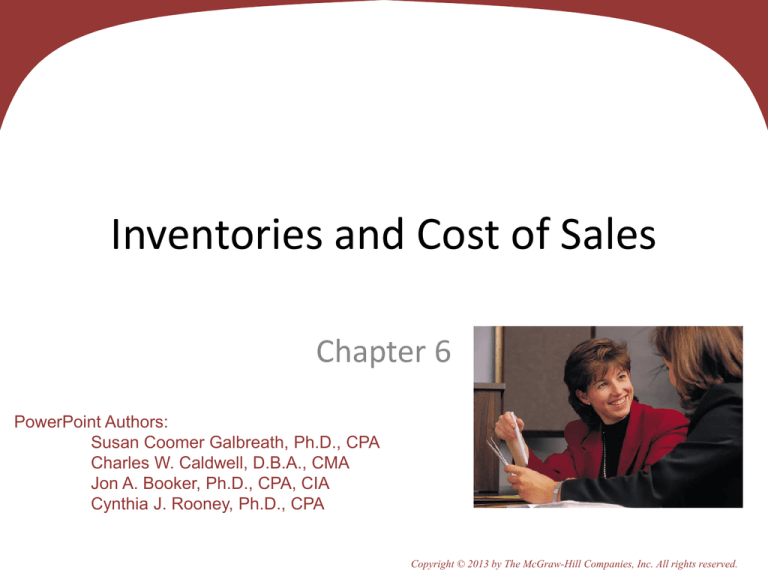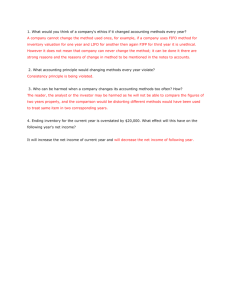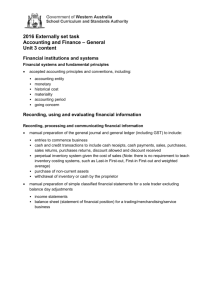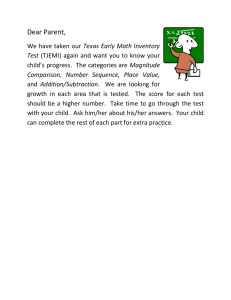
6-1
Inventories and Cost of Sales
Chapter 6
PowerPoint Authors:
Susan Coomer Galbreath, Ph.D., CPA
Charles W. Caldwell, D.B.A., CMA
Jon A. Booker, Ph.D., CPA, CIA
Cynthia J. Rooney, Ph.D., CPA
Copyright © 2013 by The McGraw-Hill Companies, Inc. All rights reserved.
6-2
C1
Determining Inventory Items
Merchandise inventory includes all goods that a
company owns and holds for sale, regardless of where
the goods are located when inventory is counted.
Items requiring special attention include:
Goods in
Transit
Goods on
Consignment
Goods
Damaged or
Obsolete
6-3
C1
Goods in Transit
FOB Shipping Point
Public
Carrier
Seller
Buyer
Ownership passes
to the buyer here.
Public
Carrier
Seller
FOB Destination Point
Buyer
6-4
C1
Goods on Consignment
Merchandise is included in the inventory of the
consignor, the owner of the inventory.
Consignee
Thanks for selling my
inventory in your
store.
Consignor
6-5
C1
Goods Damaged or Obsolete
Damaged or obsolete goods are not counted in
inventory if they cannot be sold.
Cost should be reduced to net realizable
value if they can be sold.
6-6
C2
Determining Inventory Costs
Include all expenditures necessary to bring an item
to a salable condition and location.
Minus
Discounts and
Allowances
Plus Import
Duties
Invoice
Cost
Plus
Freight
Plus
Insurance
Plus
Storage
6-7
C2
Inventory Costing under
a Perpetual System
Inventory
affects . . .
Balance
Sheet
Income
Statement
The matching
principle requires
matching costs
with sales.
6-8
P1
Inventory Cost Flow Assumptions
First-In, First-Out
(FIFO)
Assumes costs flow in the order
incurred.
Last-In, First-Out
(LIFO)
Assumes costs flow in the
reverse order incurred.
Weighted
Average
Assumes costs flow at an
average of the costs available.
6-9
P1
First-In, First-Out (FIFO)
Oldest
Costs
Cost of
Goods Sold
Recent
Costs
Ending
Inventory
6 - 10
P1
Last-In, First-Out (LIFO)
Recent
Costs
Cost of
Goods Sold
Oldest
Costs
Ending
Inventory
6 - 11
P1
Weighted Average
When a unit is sold, the average
cost of each unit in inventory is
assigned to cost of goods sold.
Cost of Goods
Available for
Sale
÷
Units on hand
on the date of
sale
6 - 12
A1
Financial Statement Effects
of Costing Methods
Because prices change, inventory methods nearly always
assign different cost amounts.
6 - 13
A1
Financial Statement Effects
of Costing Methods
Advantages of Methods
Weighted
Average
First-In,
First-Out
Last-In,
First-Out
Smoothes out
price changes.
Ending inventory
approximates
current
replacement cost.
Better matches
current costs in cost
of goods sold with
revenues.
6 - 14
A1
Tax Effects of Costing Methods
The Internal Revenue Service (IRS) identifies several
acceptable inventory costing methods for
reporting taxable income.
If LIFO is used for tax
purposes, the IRS requires it
be used in financial
statements.
6 - 15
A1
Consistency in Using Costing
Methods
The consistency principle requires a
company to use the same accounting
methods period after period so that financial
statements are comparable across periods.
6 - 16
P2
Lower of Cost or Market
Inventory must be reported at market
value when market is lower than cost.
Defined as current
replacement cost
(not sales price).
Consistent with
the conservatism
principle.
Can be applied three ways:
(1)
(2)
(3)
separately to each
individual item.
to major categories of
assets.
to the whole inventory.
6 - 17
A2
Financial Statement Effects of
Inventory Errors
Income Statement Effects
Inventory Error
Understate ending inventory
Understate beginning inventory
Overstate ending inventory
Overstate beginning inventory
Cost of Goods Sold
Overstated
Understated
Understated
Overstated
Net Income
Understated
Overstated
Overstated
Understated
6 - 18
A2
Financial Statement Effects of
Inventory Errors
Balance Sheet Effects
Inventory Error
Understate ending inventory
Overstate ending inventory
Assets
Equity
Understated Understated
Overstated
Overstated
6 - 19
Global View
Items and Costs Making Up Inventory
Both U.S. GAAP and IFRS include in inventory all items that a company owns
and holds for sale plus all cost expenditures necessary to bring those items to a
salable condition and location.
Assigning Costs to Inventory
Both U.S. GAAP and IFRS allow companies to use specific identification, FIFO,
and Weighted Average. IFRS does not currently allow use of LIFO.
Estimating Inventory Costs
Both U.S. GAAP and IFRS require companies to write down inventory when its
value falls below recorded cost. U.S. GAAP prohibits any later increase in
value. IFRS does allow reversals of write downs up to the original acquisition
cost. Neither allow inventory to be adjusted upward beyond the original cost.
6 - 20
P3
Appendix 6A: Inventory Costing
under a Periodic System
LIFO computation of COGS
and ending inventory under
a periodic system.
6 - 21
P4
Appendix 6B:
Inventory Estimation Methods
Inventory sometimes requires estimation for interim statements or
if some casualty such as fire or flood makes taking a physical
count impossible.
Retail Inventory Method
Gross Profit Method
6 - 22
End of Chapter 6





